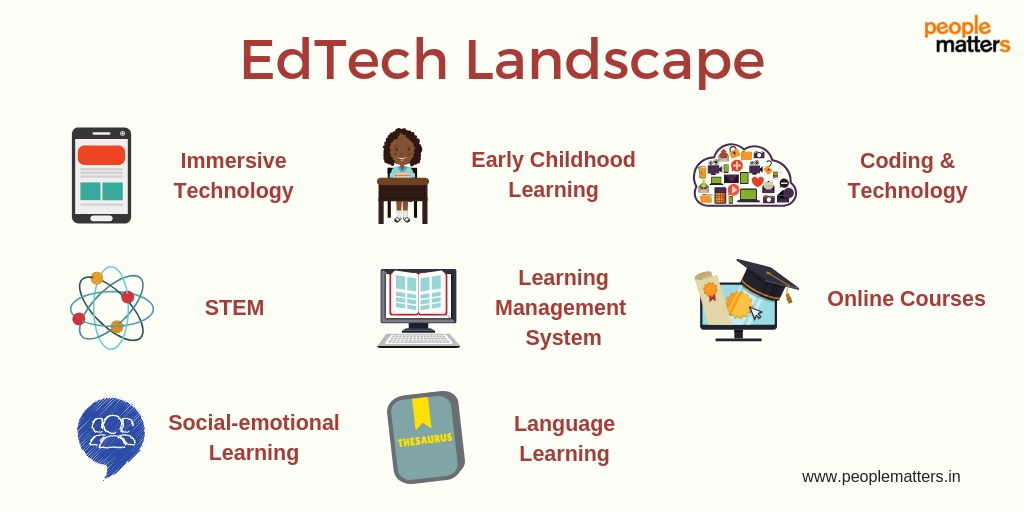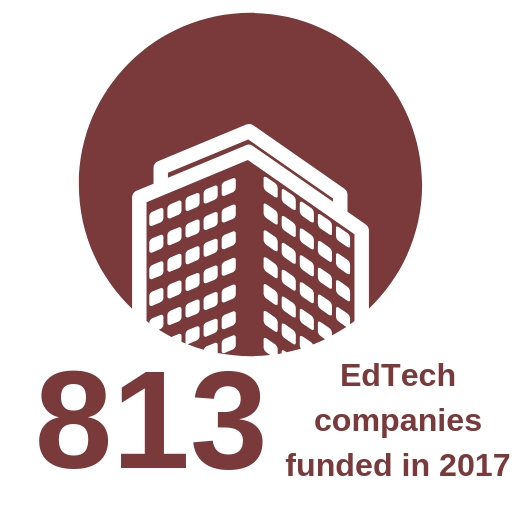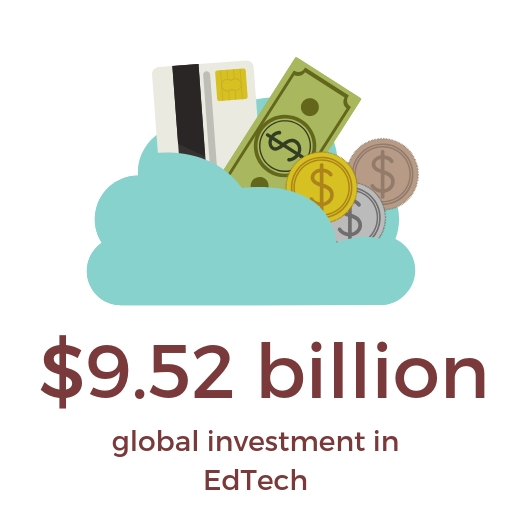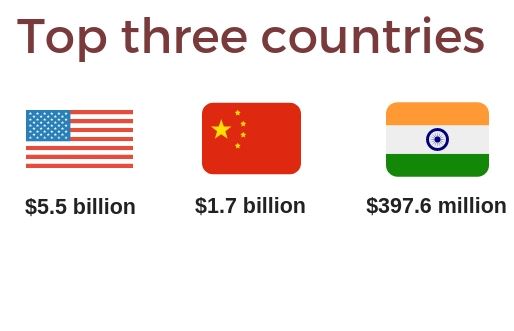SPONSOR: Betteru Education Corp. BTRU: TSX-V Connecting global leading educators to the mass population of India. BetterU Education has ability to reach 100 MILLION potential learners each week. Click here to learn more

- Vamsi Krishna, CEO & co-founder of Vedantu, told Mint that his Bangalore-based e-learning company had managed to raise $11 million in a Series B funding round
- Vedantu, an interactive online tutoring platform where teachers provide school tuitions to students over the internet, using a real-time virtual learning environment named WAVE, a technology built in-house
Moneycontrol News @moneycontrolcom
On November 24, 2018, Vamsi Krishna, CEO & co-founder of Vedantu, told Mint that his Bangalore-based e-learning company had managed to raise $11 million in a Series B funding round. Vedantu is of course an interactive online tutoring platform where teachers provide school tuitions to students over the internet, using a real-time virtual learning environment named WAVE, a technology built in-house.
Vedantu, which means ‘knowledge network,’ offers learning flexibility with group sessions costing Rs 50-150 and a private session priced at Rs300-600. The fresh repository of funding will help the company expand and penetrate tier 2 and tier 3 where their group sessions are already doing well. The app already services 80 cities including Bengaluru, Mumbai and Delhi, and also caters to students from 36 countries and 1,200 cities, Vedantu at present tutors students from 6th to 12th grade and visualises in the near future, its entry into the GMAT and GRE competitive space.
And in a technological development initiative that will truly push e-learning beyond the regular methodolgies, the company will aim to make the sessions more personalized by tracking the student’s attention span and concept understanding using machine learning, facial recognition etc.
In this Moneycontrol Deep Dive podcast, we will examine the boom in the e-learning business-scape in India.
According a joint study by Google and KPMG, the online education sector in India is estimated to grow at a compounded annual growth rate (CAGR) of 52 percent to $1.96 billion by 2021. But coming back to the Vedantu story.
Krishna is a graduate of the Indian Institute of Technology-Bombay and founded the company in 2014 with Anand Prakash and Pulkit Jain. Mint recalls how they had previously co-founded Lakshya where they also taught.
Even though, Lakshya mentored more than 10,000 students and trained more than 200 teachers, its brick-and-mortar coaching center, was sold to MT Educare Ltd in 2012.
Krishna told Mint, “Even though Vendantu is a four-year-old company, the idea was born while we were at Lakshya. We wanted to bring good teaching to every student, which would have taken a very long time in a brick-and-mortar setting. So we decided to sell Lakshya and develop the tech for our new company,”
The idea that brick and mortar structures are obsolete for expansive learning is at the core of the e-learning boom in India.
Learning without barriers
 Not just Vedantu, but most e-learning businesses including Byju’s (Think & Learn Pvt. Ltd) and Unacademy (Sorting Hat Technologies Pvt. Ltd) understand the limitations of conventional teaching and learning and the potential of technology driven educational models that can reinvent themselves to keep up with the evolving needs of the students.
Technology has undoubtedly a wider reach than brick and mortal structures and says Mint, “Investors are betting big on such content start-ups because they can reach the 200-300 million new internet users from tier 2 and tier 3 cities. More than a dozen content deals that together amount to over $400 million are expected to be closed before the end of the year.”
And Vedantu is not the only one to benefit from this boom. Unacademy has raised a neat $21 million in a Series C round and Byju’s is set to raise $200-300 million from private equity giant General Atlantic. Mint reported in September. We quote, “In addition, Byju’s is expected to be valued at $3.5 billion, which will make it India’s fourth most valuable start-up behind digital payments firm Paytm (One97 Communications Pvt. Ltd), cab-hailing service Ola, and budget hotel chain Oyo Rooms.”
Low investment, high returns
 The upsurge in e-learning enterprises could partly be attributed to inexpensive data costs and the increased access to high-speed internet and with half a billion more Indians expected to be online for the first time in the near future , there is no reason to think small.
Others big dreamers in this space apart from Vedantu, Byjus and Unacademy are Meritnation, Cuemath and Toppr. The numbers speak for themselves.
Post the reports in October that e-learning giant Byju’s may achieve 4th rank in India’s startups class, founder Byju Raveendran claimed his company was among the few profitable Indian unicorns. What is a unicorn in business terms?
Well, it is a privately held startup company valued at over $1 billion. The term was coined in 2013 by venture capitalist Aileen Lee, choosing the mythical animal to represent the statistical rarity of such successful ventures. And Raveendran was not being immodest because in June, the company touched ₹100 crore in monthly revenue and raised its annual revenue target to ₹ 1,400 crore.
The brand’s burgeoning success is now a Harvard Business School case study.
Mint had first reported in July and September that Byju’s was in talks to raise fresh funds at a valuation of over $2 billion. Since then, investor demand has increased even more.
“Byju’s is part of a small but growing number of tech startups that have rapidly grown their businesses and consistently attracted blue-chip investors. In July 2017, Byju’s raised about $40 million from Tencent Holdings Ltd, months after raising $30 million from Verlinvest. S
ince starting out in 2008, Byju’s has raised over $240 million from Tencent, Verlinvest, Chan Zuckerberg Initiative, Sequoia Capital, Lightspeed Venture Partnersand Aarin Capital, among others,†said Mint.
Bridging the infrastructure and quality divide
 It goes without saying that that education in India has not dispersed quality in equal proportions. As Roman Saini, co-Âfounder and chief educator of Unacademy wrote in the Hindustan Times on November 8, 2018 and we quote, “The education divide in India with respect to quality and accessibility has existed for far too long. It is difficult for the existing physical infrastructure to meet the learning needs of the burgeoning population of our country which will touch 1.5 billion by 2030 and 1.7 billion by 2050 (equal to the population of China and USA combined). Digital is gaining acceptance across numerous sectors and it is only right that the education sector too reaps benefits of this digital transformation.â€
As he points out, there are barriers created by inadequate infrastructure, concentrated content and language issues that prevent large numbers of knowledge-hungry demographics from the benefits of a global education.
As he says, “It is impossible to have great teachers in each and every village/district in India. Similarly, the best teachers should not be restricted to certain institutes of the world. This is where e-learning comes in. It can level the playing field for all students. Students, in both rural and urban areas, can get access to the best learning resources, learn at their own pace and in the comfort of their own homes. Another key advantage with e-learning is that it is much easier to design courses with the latest online reference material than publishing crores of books.â€
The possibility that online education could benefit India’s youth, that forms more than 50% of the population, is exciting for e-learning entrepreneurs, educators and potential learners.
New methods of teaching
 Class room learning has its benefits and drawbacks but e-learning expands the scope, depth and reach of information with tools like gamification, that Roman says will ensure in the future that the learning process is more interactive and fulfilling.
And e-learning does not have to be impersonal because live online interaction between the students and educators can offer attention and connection that is not just virtual.
Roman says, “The role of AI and technology in all of this will be huge. AI Bots can act as study assistants that will accompany you along your learning journey. It will know your strengths and weakness inside out and will even recommend what you should read on a given day to maximise your learning outcomes.â€
Byju Raveendran, of Byju’s believes e-learning can develop and inculcate personal initiative in students and that bodes well for their future success as opposed to the “spoon feeding†that conventional education dispenses.
He is a living example of personal initiative and told Mint in April 2017, that even when he was not an education entrepreneur, he was known for pre-exam hacks and short cuts that made him an exceptional student.
And good students more often than not turn out to be good educators.
After nailing a perfect score in CAT twice and after turning down interview calls from all the Indian Institutes of Management (IIMs), and working abroad for a couple of years, he decided to take six months out to see what would happen if what he had learnt was taught with a structure.
So successful was his module, recalls Mint, that Raveendran started conducting workshops on the weekend, with the classes growing in popularity. When one classroom wasn’t enough to accommodate students, he booked an auditorium with a seating capacity of 1,200. From jetsetting across India to teach, he decided to take his modules to students and a success story was born in 2011.
At the core of his teaching module and business model is not derivation but independence, logic and life skills. Soon he started using a video format. Today as Mint informed, his high-production-value videos and content caters to the K-12 (kindergarten-Class XII) segment, with more than 500 members in the research and development team.
Big numbers that keep getting bigger
 The e-learning entrepreneurs know that they are on to something. As Mint reported, “There are about 20 million children between Classes VI and XII in India who have access to the Internet and take private coaching classes, which translates to an addressable market opportunity of about $2.5 billion, according to research by consulting firm RedSeer Consulting.â€
Not surprising then that since launching in 2015, the Byju’s app has had more than six million downloads. It had 3,20,000 active users as of November last year. The number of people who buy its premium service is growing every month, claims the firm.
The paper also quotes Kunal Walia, founder and managing partner at Khetal Advisors, a Bengaluru-based investment bank that has worked with multiple education start-ups, “A great company will be converting anywhere around 8-12 percent of people who try out their app. 8-12 percent is a fairly high number given the fact that in education your ticket sizes are larger as well. You’re no longer selling a Rs500-product or a Rs 200-product, you’re selling a product which runs into thousands of rupees. Also, with education, unlike most of the sectors, the repeat rates are very high. For example, a student would start with Byju’s in the sixth standard or seventh, so Byju’s is looking at a four-year or seven-year timeline in certain cases, where they can continue to tap into the same user.â€
The B2C gameplan
 Not just Byju’s, but many successful e- learning initiatives have gauged the business-to-consumer (B2C) market effectively by making their services user and cost friendly so that both children and parents are convinced by the apps ability to deliver and engage.
Personalising virtual learning is a big part of that. Byju’s for instance has designed personalized learning through what it calls a “knowledge graphâ€. Mint informs that with this, the app learns which concepts a student may need more practice at, and adjusts learning plans accordingly.
Raveendran also told Mint and we quote, “Our product and go-to-market are both targeted at students. B2C is our only channel. We’re not trying to change the system. It can easily coexist with the system. It’s not a replacement of teachers.â€
Byju’s offline presence also helped in gaining parents’ trust in the brand, according to Walia of Khetal Advisors.Byju’s dream is to take education deeper and try and bridge India’s rural and urban divide and to create a learning culture where students learn and not just memorize. And develop a life-long thirst for knowledge that was earlier restricted by the fear of exams. The Byju’s smartphone app—and portal apart from offering study material for classes 4-12, also offers help to succeed at competitive exams like JEE, NEET, CAT, IAS, GRE and GMAT.
The positively disruptive force of e-learning
 In August this year, Priya Singh wrote in Sunday Guardian just how digital technology has proved to be a disruptive force for the education sector, changing the old paradigms of teaching and helping create the climate for more personalised forms of learning.
The reason why e-learning apps are growing popular in India is because they are challenging one dimensional teaching and emphasising “method†over the expertise of teachers, she wrote and added, “According to this new model of education, driven for the most part by digital technology, the teacher is sidelined, as content—as learning—takes centre stage.”
She also cites Byju’s success to prove her point, she cites the numbers that deserve to be repeated here. The platform now has over 22 million registered users, 1.4 million paid subscribers, an addition of 1.5 million registered users every month, more than 100% growth and the pride of becoming the first Asian company to get investment from the Chan Zuckerberg Initiative, the philanthropic organisation founded by Facebook’s boss Mark Zuckerberg and his wife Priscilla Chan. And all this was achieved in just three years.
The article informs also how the disruptive presence of technology has also educated teachers to adapt to the changing learning environment.
Not surprisingly then some platforms are not content with offering supplementary modules but also short-term degree courses.
We quote, “One such example is Simplilearn, an online certification and training platform with offices in Bangalore. They offer online courses in cyber security, cloud computing, project management, digital marketing and data science among other subjects. “
The possibilities of learning online are inexhaustible and Coursera, a California-based online learning platform that offers certified courses from the world’s best universities—including Yale, Princeton and Stanford—has been adding rapidly to its subscriber base in India, informs the piece.
Raghav Gupta, Director, India and APAC, Coursera told the Sunday Guardian, “India has a lot to gain from online learning. About one million people enter the workforce every month with no guarantee that they will have the competencies to succeed in jobs of the future. Even as technology renders many skills obsolete, online learning will be the transformative force that empowers millions to acquire new skills. We see this trend reflected in our growth in India. We now have 3.3 million Indian learners on the platform, while adding 60,000 new users every month. Our platform is giving employers and professionals the much-needed opportunity to access the best and most relevant content the world has to offer and learn the skills needed to compete in the new economy.†Unquote.
Another big player, says the piece, is edX, a “massive open online course†(MOOC) platform, founded by the Massachusetts Institute of Technology and Harvard University. It offers courses on subjects like artificial intelligence, machine learning, data science, business and management, leadership, soft skills, and so on.
We quote Amit Goyal, Head, India and South East Asia, edX, “Lack of employer recognition and academic credits are the sonic barriers of online learning in India and the world. Companies like edX are now offering university credits for their online programmes. For example, edX credit-backed MicroMasters programs can be taken completely online, and every programme leads to an on-campus master’s level credential at an accelerated and cost-efficient manner. Students can save approximately 20-50% of their on-campus degree time and money after completing edX MicroMasters programme.â€
India incidentally forms the second largest learner base for edX, after the USA.
And Goyal believes, e-learning is going to bridge the digital divide in India and that educational institutes who may not afford high-quality teachers can increase their teaching standards by referring to online courses taught by world-class professors and adopt flip-learning pedagogy.
Observers and most e-learning businesses know that classroom learning cannot be replaced but it can be updated.
The piece quotes Divya Gokulnath of Byju’s, “Technology has played a key role in disrupting this sector and will continue to shape the teacher-student relationship by offering better accessibility, distribution and formats of delivery.†The combined power of artificial intelligence, machine learning and data analytics, she says will reshape learning.
The potential for growth is endless
 A piece published in India Today by Varun Saxena, Founder, Career Anna another online learning platform cited a report by KPMG, that the Indian online education industry will register a 6X growth in 2021. From 1.6 million users in 2016, it will grow to 9.6 million users by 2021. It will also be worth $1.96 billion.
“Projections show that the e-learning market worldwide is forecast to surpass 243 billion US dollars by 2022. It clearly shows that e-learning has become a global trend, and more and more people are preferring it over traditional classrooms,†said the article.
One reason for this shift, according to Varun is that the number of jobs involving routine skills — both physical and cognitive — is shrinking, and with increasing automation, newer opportunities are being created every day.
We quote, “Co-branded courses with corporates and educational institutes having live industry projects, real-time mentoring and peer to peer interactions on an online platform, with an exposure to connect with anyone across the globe interested in a same skill set is another main reason to help online learning score a brownie point over traditional learning which limits one to brick and mortar, or to a particular location and city.â€
The dream of learning from a Harvard professor in a small Indian town, no longer seems impossible.
Varun sums it up, “Online learning is hence, steadily disrupting the hackneyed chalk and talk’ education system in India because of the immense benefits it has to offer.†Unquote.
The need to connect the unconnected
 Digital education however must expand beyond eager urban markets to regions that do not have ready internet accessibility.
As YourStory stated in a November piece this year, “The Internet has helped us in many ways – from education to entertainment. But what about areas that cannot connect to the internet?â€
The answer, the piece informs is Chhota Internet – a Content Access Management Device (CAMD) that can help make education accessible to all.
“In a district of Ghaziabad in Uttar Pradesh, 197 upper primary schools will adopt Chhota Internet to increase learning opportunities for their students. Using this, the schools will be able to access better quality educational material over a WiFi network without using the internet. This digital initiative will also allow schools to focus on each student’s progress and help them design custom-based programmes to further enhance a student’s performance. Digital literacy, when harnessed in a controlled and responsible environment, can help schools find, evaluate, utilise, share and create content using information technologies and the internet.â€
Inventions like Chhota Internet thus can serve as a shot in the arm of traditional educational system in the rural area and work past issues like lack of internet penetration, shortage of quality teachers etc.
The piece quotes Sandeep Arya, CEO and Chairman of Chhota Internet, “As rural India prepares for a tectonic change in education with the launch of digital classrooms, we need to ensure consistent implementation of digital literacy on a large-scale to ensure quality education. More of this can happen when corporations direct their CSR funds to this cause instead of solely depending upon government funding. Chhota Internet will achieve this by bringing students in rural India abreast with the rest of the world, in terms of providing access to a more advanced system of education that is loaded with the latest technological aids, paving the way for future growth via innovative technology.â€
A revolution indeed is not a revolution unless it benefits the ones with the least amount of privilege and hopefully initiatives like Chhota Internet will take e-learning to the farthest reaches of a demographically and geographically diverse country like India.
Source: https://www.moneycontrol.com/news/business/podcast-digging-deeper-e-learning-is-changing-indias-mindscape-3235601.html








 Â Â Â Â Â Â Â Â Â Â Â
                  Â
           Â
     According to Metaari advanced learning technology report 2017, over $3.79 Bn was invested in corporate-facing educational technology companies in 2017, trailing consumer-facing companies by $60 Mn. Corporate training and education buyers across the globe are migrating rapidly away from legacy products like self-paced courseware and are now avid buyers of psychometric Game-based Learning, AI-based Learning, Cognitive Learning, and Mixed Reality Learning (that includes both VR and AR-based products).
According to Metaari advanced learning technology report 2017, over $3.79 Bn was invested in corporate-facing educational technology companies in 2017, trailing consumer-facing companies by $60 Mn. Corporate training and education buyers across the globe are migrating rapidly away from legacy products like self-paced courseware and are now avid buyers of psychometric Game-based Learning, AI-based Learning, Cognitive Learning, and Mixed Reality Learning (that includes both VR and AR-based products).


